
The « Maison Moderne » of Julius Meier-Graefe — Part 1 June 11, 2025
Thanks to our Swiss member Michel Philippe Dietschy-Kirchner, we got in touch with Bertrand Mothes, author of a study on “La Maison Moderne”, founded in Paris by German art critic Julius Meier-Graefe. Often overlooked in favor of its better-known competitor, Siegfried Bing’s La Galerie de l’Art Nouveau, it nevertheless published leading decorative artists such as Maurice Dufrène. Its links with Guimard are tenuous and indirect, but not non-existent. Bertrand Mothes has given us the honor of sharing a summary of his work with us.
The last decade of the 19th century was a period of radical change in the field of decorative arts in Europe. Artists, patrons, critics, and institutions actively participated in this renaissance of applied arts, each according to their own methods and ideas, but always with the aim of breaking away from the historicist pastiche in which decorative artists and architects had become trapped during the second half of the century. In this climate of emulation, the role of dealers should not be overlooked. In 1895, Siegfried Bing opened the Galeries de l’Art Nouveau at 22 Rue de Provence in Paris. While this gallery is now the best known and the one with the richest historiography, it is important to consider the environment of Parisian art galleries of the period, an environment that included “La Maison Moderne”. This establishment, founded by German art critic and historian Julius Meier-Graefe in 1899, stood alongside Bing’s Art Nouveau as the second center for the trade in innovative decorative arts in the French capital at the turn of the century. Like the Galerie de L’Art Nouveau, La Maison Moderne was a shop where Parisians could come to furnish their homes and buy works of art, trinkets, and fashion accessories. However, its structure and operation differed from those of 22 rue de Provence and reflected the mindset of its owner. Similarly, the selection of artists- some of whom worked for both stores—reflected Julius Meier-Graefe’s aesthetic choices.
The soul of « La Maison Moderne”
The first element to examine to understand the origins of La Maison Moderne is the definition of the goals of its creator, Julius Meier-Graefe. Indeed, the gallery was modeled according to his wishes, and he embodied its spirit throughout its entire period of activity. The son of Edward Meier, one of the leaders of the steel industry in Germany, and Marie Graefe, who died giving birth to him [2], Julius Meier-Graefe was born on June 10, 1867, in Reșița [3]. His family moved to the Rhineland and the young Julius grew up near Düsseldorf. He obtained his Abitur in 1879 and began studying industrial engineering with a view to taking over his father’s business [4], first in Munich in 1888 and then the following year in Zurich and Liège. He already seemed attracted to the world of art: he visited the 1889 World’s Fair in Paris and left for Berlin in 1890. He then began studying art history under Herman Grimm and left Berlin without graduating [5].
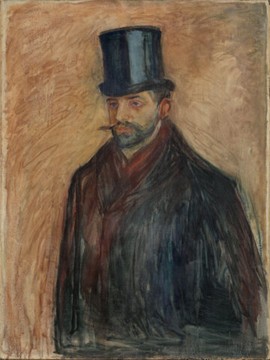
Edvard Munch, portrait of Julius Meier-Graefe, 1894. Iil on canvas hight. 100 cm, width 75 cm, collection: Nasjonalmuseet for kunst, arkitektur og design, Oslo, photo : Høstland, Børre, Creative Commons – Attribution CC-BY.
The year 1893 saw Meier-Graefe’s first involvement in the arts: he helped his friend Edvard Munch organize an exhibition and published his first work, the novel Nach Norden (“Towards the North”). That same year, he traveled to England, where he met the most important representatives of the Aesthetic Movement and Arts and Crafts, including Oscar Wilde, William Morris, Edward Burne-Jones, and Aubrey Beardsley [6]. In 1894, he helped found the Pan association and became editor of the eponymous magazine that accompanied it. He shared the title of editor-in-chief with the writer Otto Julius Bierbaum. Meier-Graefe was responsible for editing articles related to the fine arts, while Bierbaum took care of those devoted to literature [7].
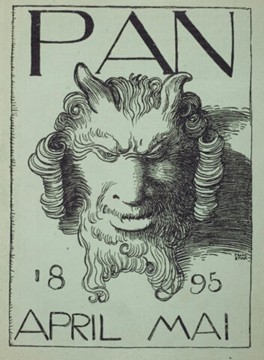
Franz von Stuck, Cover of the magazine Pan, April-May 1895. Coll. Université de Heidelberg. All rights reserved.
He then began writing about decorative arts. In his view, painting had lost touch with society, and it was necessary to turn to the applied arts to revive art [8]. Meier-Graefe thus wanted to add an art salon to the Pan association. He wanted to make this salon a new kind of venue, breaking with the exhibitions organized at the time, which no longer satisfied the public, and proposed bringing together all the arts in coherent interiors, without distinction between fine arts and applied arts. His goal was to bring artists and spectators together and create a “modern and harmonious” environment [9]. This idea of an art salon seems to have emerged in his mind after his trip with Siegfried Bing to Belgium in the spring of 1895. They visited the Maison d’Art de la Toison d’Or in Brussels. This gallery, founded in 1894 by the Société Anonyme l’Art, was located in Edmond Picard’s mansion at 56 avenue de la Toison d’Or and was run by his son William Picard. The aim of the Société Anonyme l’Art, which was to stimulate the production of applied arts, was reflected in the presentation method chosen, which was completely new at the time: the layout of the mansion was preserved and the objects—contemporary works of art and craftsmanship intended for everyday use—were displayed in the rooms. This approach differed from the usual arrangement in galleries at the time, which consisted of simply displaying the objects for sale on shelves in soulless, undecorated spaces. Bing and Meier-Graefe were impressed by its innovative approach [10]. Immediately after their visit to the Maison d’Art, Meier-Graefe and Bing also visited Henry Van de Velde, who had just begun construction of his new house, the Bloemenwerf, in Uccle. In his memoirs, Van de Velde recalls “a trip that was intended to inform them about the revival of the arts and crafts in England and various countries on the continent. From Brussels, they were to travel to England, then return via Holland to Denmark, Germany, Austria, and Czechoslovakia (11).”
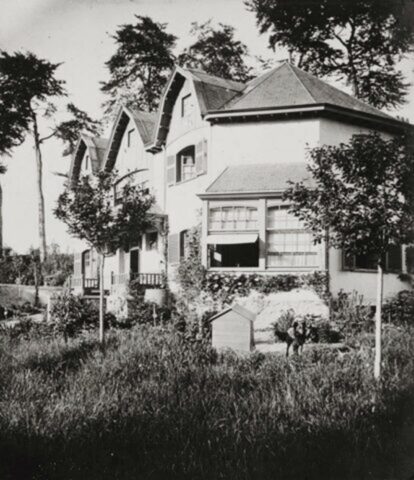
View of the Bloemenwerf, house of Henry Van de Velde, built in 1895 at Uccle in the suburbs of Brussels. All rights reserved.
Van de Velde goes on to explain Meier-Graefe’s intentions and proposals, which include expanding his network of contacts and finding new topics for articles to contribute to the development of art magazines in Germany. Meier-Graefe therefore suggests to Van de Velde that he join the foreign contributors to the magazine Pan. The two travelers are apparently convinced of the need to work with Van de Velde and are full of praise for his taste in interior design [12]. Upon departure, Bing expressed his desire to reconnect with Van de Velde with a view to a possible collaboration when he returned to Paris. It was at the end of this trip that Meier-Graefe encouraged Bing to transform his Parisian gallery, inspired by the edifying example of the Maison d’Art as an innovative gallery.
At the end of the year, Meier-Graefe left the Pan association following a disagreement over the publication, in the September-November 1895 issue of the magazine, of a lithograph by Henri de Toulouse-Lautrec, Mademoiselle Lender, in bust, which was deemed immoral by some members of the editorial board [13].
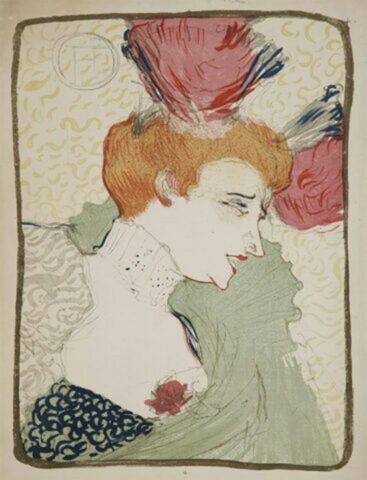
Henri de Toulouse-Lautrec, Mademoiselle Marcelle Lender en buste, 1895, color lithography on paper, Vente Tajan, Paris, 3 May 2022, lot 43. All rights reserved.
He then moved to Paris in the following months, while continuing to contribute to German magazines. From that point on, Meier-Graefe wrote little about painting and focused on the decorative arts. In parallel with his writing, at the end of 1895 he became artistic advisor to Siegfried Bing at his Art Nouveau gallery, where he organized exhibitions [14].
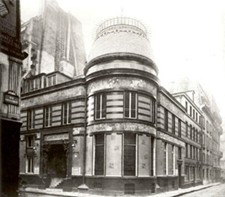
The gallery of L’Art nouveau Bing, at the angle of rue Chauchat and rue de Provence, rehabilitation by the architect Louis Bonnier in 1895. Photo Édouard Pourchet. All rights reserved.
Meier-Graefe’s role within Bing’s company placed him at the center of a network of artists, enriching the one already established in Germany. However, his actions were not without criticism from leading figures in the French art scene, such as Auguste Rodin, Octave Mirbeau, and Edmond de Goncourt, who accused him of seeking to overturn “good taste” and the tradition of French decorative arts. Meier-Graefe and Art Nouveau were nevertheless defended by eminent critics such as Camille Mauclair, Gustave Geffroy, Thadée Nathanson, and Roger Marx [15]. After six months of collaboration, Meier-Graefe left Bing’s gallery. The two men continued to see each other, however.
Julius Meier-Graefe then returned to writing. In an article published in Das Atelier in 1896, he described what he considered outdated in the field of interior design. For him, Edmond de Goncourt’s house, furnished in the 18th-century style, no longer met the needs of a late 19th-century interior:
“A modern person cannot live in Second Empire “bric-a-brac”. Taking something from another era and placing it in a new environment can be as disastrous as the barbaric imitations of old models in the decorative arts.
Meier-Graefe also criticized the “museum-like” aspect of this residence during the auction of its contents in 1897. This idea of anachronism concerning the interior decor and furnishings was a constant theme for Meier-Graefe, who used it as an argument in favor of modernity. He considered that “living in a salon in the purest Regency style is equivalent, for a citizen of the Third Republic, to donning a hammered wig and a ribboned coat” and that a collector furnishing his interior in an antique style “often makes himself look as ridiculous as the Bourgeois Gentilhomme [18].”
Another article by Meier-Graefe, published in June 1896, serves as a profession of faith and an affirmation of his commitment to supporting modern decorative arts [19]. In it, he develops his view that divides art into “external environment” and “internal environment.” According to him, the 19th century was the century of the “external environment” dedicated to realistic art, and his era reacted to this artistic conception with “fantastic” art—a term understood today as ‘symbolist’—which aimed to be “useful.” He placed the applied arts at the center of this artistic renewal and believed that modernity could win over the public through the “neutral” field of decorative arts. He was one of the persons best placed to support this development of decorative art, given his interest in it, but also thanks to his knowledge in this field and his network of contacts throughout Europe. He shared this point of view with many artists who were beginning to abandon painting and sculpture to devote themselves to “useful” art, Henry Van de Velde foremost among them.
Meier-Graefe continued to write and, in 1897, acquired the best tool available for conveying his ideas: a magazine of which he would become editor, Dekorative Kunst. This German-language magazine was co-founded and published by Hugo Bruckmann from Munich. Most of the articles were written by Meier-Graefe himself, who used a large number of different pseudonyms [20]. Modelled on the English magazine The Studio, the journal was international in its approach, being published in Germany but with offices in Paris. Its aim was also to transcend borders, as indicated in the launch brochure. Meier-Graefe explained that abstract art had become an end in itself and was now only appealing to a minority of enthusiasts, while interior design and home décor had been abandoned to unscrupulous manufacturers who were content to produce poor replicas of old styles. A reaction against this state of affairs was said to be underway, and the new magazine, devoted exclusively to modern decorative art, would participate in this renewal by preparing the ground. This focus on modern applied arts alone sets it apart from other magazines created or revamped at the same time, which were devoted to both modern and ancient art, such as the Revue des Arts Décoratifs and Art et Décoration in France, The Studio in England, and Deutsche Kunst und Dekoration in Germany.
Meier-Graefe did not just write about decorative arts, he also put his ideas into practice in his new magazine with the help of Belgian artists: the title page of the first issue of Dekorative Kunst was designed by Henry Van de Velde and Théo Van Rysselberghe [21]. Meier-Graefe called on a third Belgian artist, Georges Lemmen, to design two posters and some letterhead for other promotional materials for his magazine. Meier-Graefe took his idea even further, commissioning Van de Velde to design the magazine’s editorial offices at 37 Rue Pergolèse in the 16th arrondissement [22].
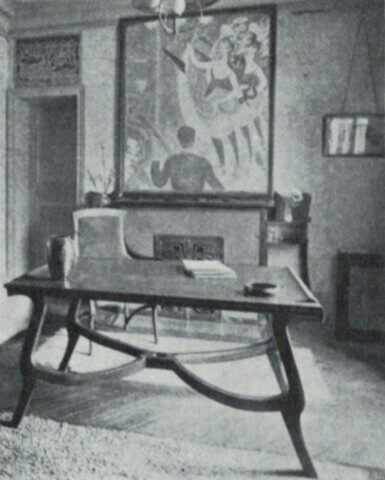
Editorial office of the magazine Dekorative Kunst in Paris, 37 rue Pergolèse, reproduced in Henry Van de Velde, Sembach, Klaus-Jürgen, ed. Hazan, 1989. Above the door is a poster by Georges Lemmen with the title of the magazine, and above the fireplace is Seurat’s Le Chahut (now in the Musée d’Orsay). All rights reserved.
It seems that Meier-Graefe was already behind the collaboration between the Belgian decorator and Siegfried Bing in 1895[23]. Following the negative reactions to his interior designs at L’Art Nouveau—Rodin called Van de Velde “a barbarian” [24]—Van de Velde seemed to have lost his appreciation for Paris [25], but Meier-Graefe, convinced of his potential success in France, did everything he could to get him recognized there.
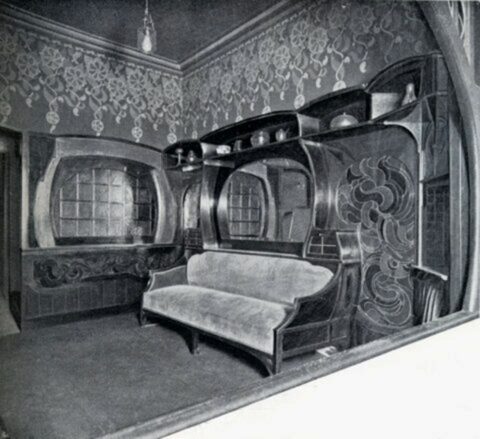
Salon designed by Henry Van de Velde for the opening of the Bing Art Nouveau Gallery in 1895. Photograph reproduced in Gabriel P. Weisberg, Les Origines de l’Art Nouveau, la maison Bing, published by the Musée des Arts décoratifs, 2004. All rights reserved.
In view of the success of Dekorative Kunst, and in order to spread his ideas even more widely, Meier-Graefe founded the magazine L’Art décoratif, the French counterpart to the original publication. The first issue was published in October 1898 [26]. It was entirely dedicated to Henry Van de Velde, whom Meier-Graefe commissioned to design the cover [27] and redesign the magazine’s offices.
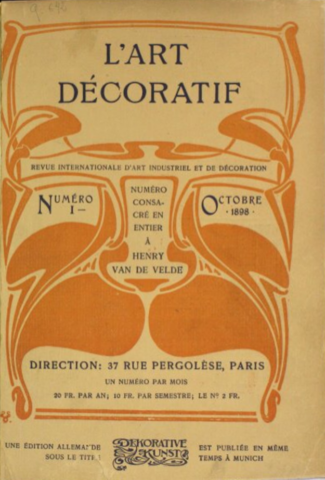
Henry Van de Velde, cover of the first issue of the magazine L’Art Décoratif, October 1898. Library of the National Institute of Art History, Jacques Doucet collections. All rights reserved.
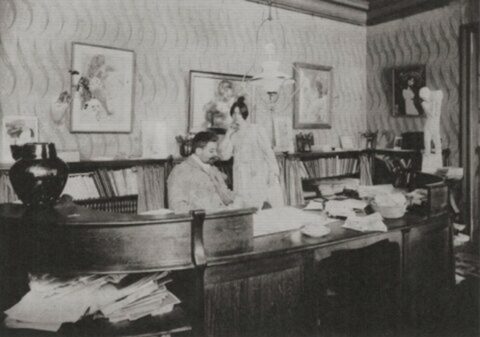
Julius Meier-Graefe and his wife in his office at the editorial office of the magazine L’Art Décoratif, 37 rue Pergolèse in Paris, circa 1898-1899. On the wall to the right, Madonna by Edvard Munch. Photo Royal Library of Belgium, Archives and Museum of Literature, reproduced in Henry Van de Velde Passion Fonction Beauté, published on the occasion of the exhibition of the same name at the Cinquantenaire Museum in Brussels, 2013, Lanoo, Tielt, 2013. All rights reserved.
The subtitle of L’Art décoratif, Revue internationale d’art industriel et de décoration, sums up the battle that Meier-Graefe had undertaken the previous year in the German-speaking world and which he now wished to wage in the French-speaking world. His approach was outlined in the preface to the first issue. He wanted to find a rational way of organizing the production and distribution of modern art objects. He wanted to break with the French tradition of promoting “rare objects.” He deplored the situation in the art industries at the time, which forced decorative artists to respond only to commissions from wealthy collectors and did not encourage industrialists with the necessary infrastructure to manufacture objects in large quantities to call on artists to design their models, producing only objects that copied old styles. Meier-Graefe wanted to change this state of affairs and hoped to reconcile artists with industry, which alone can make beauty accessible to the masses. From the third issue of L’Art décoratif, his desire to contribute to the art trade was clear: a fan by Georges de Feure, produced in a limited edition of 100, was offered to readers of the magazine, who had to contact the editorial office to order the item. This was Meier-Graefe’s first venture as an art dealer.
The need for a new gallery
A radical change was afoot in Meier-Graefe’s work. Although he left Bing’s Art Nouveau to concentrate on his writing, he continued to regard it as the ideal structure for promoting the modern style in Paris. However, during the last years of the century, he began to change the decorative concept he wanted to promote at L’Art Nouveau. Barely a year after the gallery opened, profits were already falling short of expectations, as Paul Signac pointed out: “Business is not going well at all; he doesn’t know what he wants, nor what customers want. He is in dire straits and I think he will soon move on to other pursuits[ 31].” Bing therefore began to favor artists with a more “French” conception of decorative arts [32]. This ‘return’ to the “French tradition” of furniture culminated at the 1900 World’s Fair, where Bing’s pavilion presented works by Georges de Feure, Édouard Colonna, and Eugène Gaillard.
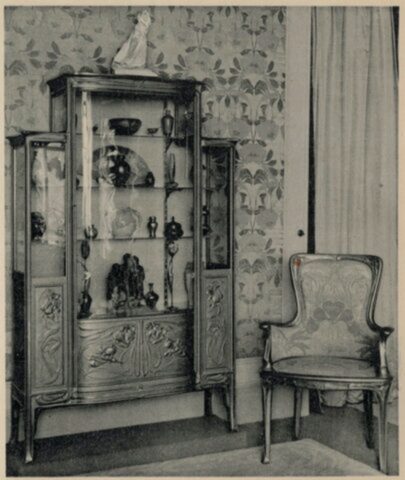
Gilded wood display cabinet and armchair by Georges de Feure in the Bing Pavilion at the 1900 Paris World’s Fair. Portfolio Modern-style furniture 1900 World’s Fair. Private collection.
Meier-Graefe, for his part, “will not allow any kind of compromise, at least for the moment [33].” He was already aware of the economic and financial stakes involved in a business such as L’Art Nouveau. The companies run by Louis Majorelle and Gustave Serrurier-Bovy were models of thriving businesses with processes that differed from those of Bing. Even though he set up his own workshop to create luxury items for his gallery, Meier-Graefe considered that he had “underestimated the enormous growth of this market for new products” and that he had not taken into account the competitive environment specific to Parisian furniture galleries[34].
These various factors led Meier-Graefe to consider setting up his own private art gallery, which he would run and where he would exhibit only works by artists who shared his vision of modern decorative art. By 1899, Meier-Graefe had given the matter a great deal of thought and his ideas had matured. The project was launched later that year. Drawing on his “instinctive feelings and knowledge,” Meier-Graefe began to assemble a “team” of artists who would select the works to be sold in his gallery and decide how and by whom it would be designed. From that date on, he gradually gave up the editorial direction of Dekorative Kunst and L’Art décoratif to devote himself entirely to his project [36]. He was also able to start his business thanks to a large inheritance from his father, who died in 1899. However, the lack of archives does not allow us to know whether Meier-Graefe received any financial support other than his inheritance and personal investment when he set up his gallery [37]. His change of activity and his increasing involvement were praised in the preface to Documents sur l’Art Industriel au vingtième siècle (Documents on Industrial Art in the Twentieth Century), published in 1901 by La Maison Moderne:
“Ten years ago, it was his pleasure to support, in magazines, with passionate enthusiasm, the doctrine of the equality of the arts […]; but Mr. Meier-Graefe was not content with the contemplative and usually ineffective action devolved to the critic; he wanted to prove his words, to move from theory to practice, from propaganda to fact. [38]“
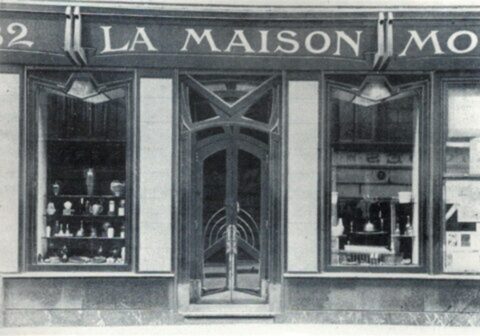
Front of La Maison Moderne, 82 rue des Petits-Champs in Paris, Deutsche Kunst und Dekoration, 1900, reproduced in Henry van de Velde, Ein europäischer Kunstler seiner Zeit, Sembach/Schulte, catalog of the eponymous exhibitions 1992-1993, ed. Weinand-Verlag, Cologne, 1992. All rights reserved.
The opening of the gallery was reported in the magazines of which he was still editor. The September 1899 issue of L’Art décoratif featured a page written by Meier-Graefe himself (under a pseudonym) announcing the upcoming opening of La Maison Moderne, “a new house for the production and sale of everyday art objects.” The following issue specified the date of the opening, scheduled for the second half of October, and announced that a preview would be held to which subscribers to the magazine would be invited[40]. However, the opening to the public was postponed, as reported in the November 1899 issue, “due to renovation work that the contractors had not anticipated[41].” This is the last mention of the gallery’s imminent opening. A letter sent by Van de Velde to his wife Maria, dated November 15, 1899, and mentioning the opening of the gallery, allows us to estimate more precisely the date of this event, which must have taken place between November 1 and 15, 1899. Van de Velde explains that the opening of La Maison Moderne was not as famous a social event as that of L’Art Nouveau four years earlier, but he was not concerned: “This opening is not sensational, far from it, but nevertheless I believe in the success of the venture[42].” Despite the lack of enthusiasm generated by the creation of a new gallery, Meier-Graefe and his collaborators were convinced of their innovative potential and the future success of their venture.
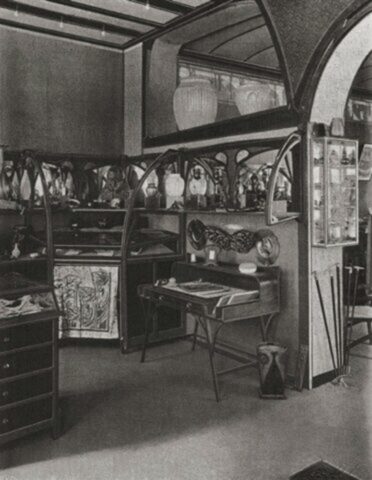
Interior design of La Maison Moderne in Paris, Deutsche Kunst und Dekoration, 1900, reproduced in Henry Van de Velde Passion Function Beauty, published on the occasion of the eponymous exhibition at the Musée du Cinquantenaire in Brussels, 2013, Lanoo, Tielt, 2013. All rights reserved.
La Maison Moderne was, for its creator, an unprecedented venture: opposed to trade shows and official exhibitions due to the multiplicity of objects on display and their presence in multiple copies, but also opposed to department stores thanks to the indisputable artistic quality of the objects offered for sale, it was also different from workshops’ own shops, such as those of the Daum brothers or Louis Majorelle. La Maison Moderne was similar in style to Bing’s gallery, but Meier-Graefe believed that there was a significant difference between the two, beyond mere stylistic differences. Unlike Bing, who chose to appeal to a very wealthy clientele, Meier-Graefe wanted to include his establishment in “a new category of ‘modern art galleries’ that would meet the needs of a growing number of people for whom the items sold in existing shops were difficult to access[43].” The target audience was therefore much broader than Bing’s. The reason given for this choice was the desire to make art accessible to as many people as possible. According to the author of the preface to Documents sur l’Art Industriel au vingtième siècle (Documents on Industrial Art in the Twentieth Century), “the creation of the Maison Moderne had no other origin than the firm determination to satisfy an ideal that had been that of William Morris, our neighbors across the Channel, and which, until 1898, no one had succeeded in achieving among us.” This social commitment highlighted at the gallery’s opening can also be explained by the fact that a shop selling quality items at reasonable prices can expect to make more sales than a gallery like Bing’s, and therefore be economically viable. Indeed, the financial aspect of La Maison Moderne is an important factor to consider while Meier-Graefe’s ideas were honorable and his desire to fill the living spaces of modest households was commendable, he needed a certain amount of financial prosperity to make his venture a success. The social ideal of the Art Nouveau movement is thus subject to economic success, without which no creation and dissemination of new objects is possible. This financial health would also encourage the most renowned artists to want to collaborate with the gallery. These guiding principles were present from the outset in the gallery’s policy and were explained in the articles accompanying its opening[45]. In the preface to Documents sur l’Art Industriel au vingtième siècle (Documents on Industrial Art in the Twentieth Century), the operating principles and the variety of objects sold are highlighted. A year after the opening, Max Osborn explained the gallery’s position in the Parisian art market and the role of its director:
“One of the most recent phenomena of the present day, in which art and craftsmanship are finally reunited after too long a separation, is the decorative arts bazaar, a hybrid establishment halfway between an art gallery and a department store, offering both luxury goods and everyday objects, and whose owner is an unusual combination of connoisseur, artist, art critic, patron, and businessman in the noblest sense of the word[46].“
Max Osborn also highlights the paradoxical nature of the situation of the Parisian decorative arts: the two most important establishments were run by Germans who were trying, in their own way, to ”root” Art Nouveau in France. Van de Velde mentions in his memoirs the strength of will shown by Meier-Graefe regarding his conception of the decorative arts, but expresses doubts about his ability to carry out a project of this magnitude:
“La Maison Moderne had to differentiate itself from Samuel Bing’s Art Nouveau galleries through the uncompromising nature of its program; the aim was to bring together that section of the public that felt attracted to an evolution in painting and sculpture towards more assured forms and essential qualities. Julius Meier-Graefe could carry out such a program. He certainly did not lack ambition, but he lacked the financial means and the perseverance necessary to devote himself solely to this mission[47].”
Van de Velde’s fears were also justified by the scale Meier-Graefe wanted to give his gallery. While opening his first establishment in Paris, he also wanted to create branches throughout Europe to promote modern industrial art[48].
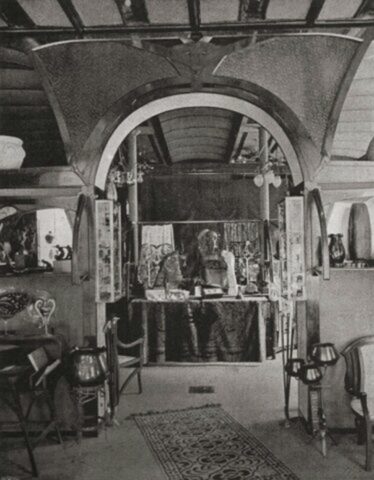
Interior design of La Maison Moderne in Paris, Deutsche Kunst und Dekoration, 1900, reproduced in Henry Van de Velde Passion Function Beauty, published on the occasion of the eponymous exhibition at the Musée du Cinquantenaire in Brussels, 2013, Lanoo, Tielt, 2013. All rights reserved.
Meier-Graefe’s initiative was highly innovative in France at the time, and La Maison Moderne was to be the springboard for a new alliance between art, industry, and commerce. He sought to form the only trio capable of offering affordable objects and furnishings to a skeptical public and critics: the artist, the manufacturer, and the merchant [49]. Once his gallery was open, Meier-Graefe gradually withdrew from the management of Dekorative Kunst and L’Art décoratif, although the fact that the gallery and the magazines shared administrative offices on Rue des Petits-Champs and the frequency of his articles in both magazines indicate that this withdrawal was never complete. Although he readily presented himself as the director of La Maison Moderne and L’Art décoratif, he found it difficult to openly reconcile the management of a modern art gallery with writing articles in magazines that championed the same cause[50]. He managed to carry out a concerted campaign by using his real name at the head of La Maison Moderne and pseudonyms for the publication of his articles.
While the founding of Dekorative Kunst and then L’Art décoratif brought Meier-Graefe to the forefront of the Parisian art scene, the creation of La Maison Moderne distinguished him as one of the leading players in the art market at the beginning of the 20th century. He now had all the means necessary to disseminate his ideas through published writings and objects offered for sale. Furthermore, his position as gallery director allowed him to select the artists with whom he wished to collaborate, thereby establishing a Europe-wide creative network that helped fuel the climate of emulation that prevailed in the French capital at the time. However, his position as a defender of modern decorative art, determined to “declare war on French taste and the situation in France,” made La Maison Moderne a risky venture, which had to convert the Parisian public to modern taste as quickly as possible or face extinction.
Bertrand Mothes
Translation Alan Bryden
Notes
[1] Cat. exp. The Origins of Art Nouveau: The Bing House, Antwerp, Fonds Mercator, Paris, Les Arts décoratifs, Amsterdam, Van Gogh Museum, 2004.
[2] Lee SORENSEN, “Julius Meier-Graefe,” Dictionary of Art Historians, [http://www.dictionaryofarthistorians.org/meiergraefej.htm].
[3] City of Banat, now in Romania.
[4]Kenworth MOFFETT, Meier-Graefe as Art Critic, Munich, Prestel-Verlag, 1973, p. 9.
[5] Lee SORENSEN, “Julius Meier-Graefe,” Dictionary of Art Historians, [http://www.dictionaryofarthistorians.org/meiergraefej.htm].
[6] Exhibition catalog, Alexandre Charpentier (1856-1909). Naturalisme et Art Nouveau, Paris, Musée d’Orsay, N. Chaudun, 2007, p. 126.
[7] Jean-Michel LENIAUD, L’Art nouveau, Paris, Citadelles & Mazenod, 2009, pp. 453-454.
[8] Exhibition catalog, Art nouveau: Symbolismus und Jugendstil in Frankreich, Stuttgart, Arnoldsche, 1999, p. 150.
[9] Catherine KRAHMER, “Meier-Graefe et les arts décoratifs, un rédacteur à deux têtes” in Alexandre KOSTKA, Françoise LUCBERT (eds.), Distanz und Aneignung, Relations artistiques entre la France et l’Allemagne 1870-1945, Berlin, Akademie Verlag, 2004, p. 232.
[10] Cat. Exp Georges Lemmen 1865-1916, Brussels, Crédit Communal, Ghent, Snoeck-Ducaju & Zoon, Antwerp, Pandora, 1997, p. 51.
[11] Henry VAN DE VELDE, Récit de ma vie. 1, Anvers, Bruxelles, Paris, Berlin (1863-1900), text compiled and annotated by Anne VAN LOO and Fabrice VAN DE KERCKHOVE, Brussels, Versa, Paris, Flammarion, 1992, p. 263.
[12] The conversation takes place in the music room of Van de Velde’s mother-in-law’s house, which he has just redecorated for Irma Sèthe, his wife Maria’s sister, with wallpaper featuring a dahlia pattern.
[13] Roger CARDON, Georges Lemmen (1865-1916), Antwerp, Petraco-Pandora, 1990, p. 448.
[14] Les origines de L’Art nouveau : la Maison Bing, op. cit., note 1, p. 236.
[15] MOFFETT, op. cit., note 4, p. 28.
[16] Julius MEIER-GRAEFE, “L’Art Nouveau. Das Prinzip,” Das Atelier, 1896, no. 5, pp. 2-4; translation by Edwin Becker in Les origines de L’Art nouveau : la Maison Bing, op. cit., note 1, pp. 129-131.
[17] MOFFETT, op. cit., note 4, p. 28. [18] Documents sur l’Art Industriel au vingtième siècle. Photographic reproductions of the main works of contributors to La Maison Moderne.Commented by R. [Raoul] AUBRY, H. [Henri] FRANTZ, G.-M. JACQUES [pseudonym Julius MEIER-GRAEFE], G. [Gustave] KAHN, J. [Julius] MEIER-GRAEFE, Gabriel MOUREY, Y. [Yvanhoé] RAMBOSSON, E. [Émile] SEDEYN, Gustave SOULIER, G. [Georges] BANS, with nine additional illustrations by Félix VALLOTTON Les Métiers d’Art. Paris, Édition de La Maison Moderne, 1901, p. 11 [Preface].
[19] Julius MEIER-GRAEFE, “Dekorative Kunst,” Neue Deutsche Rundschau, June 1896, pp. 543-560.
[20] On Meier-Graefe’s pseudonyms, see KRAHMER, op. cit., note 9, pp. 248-249.
[21] Catherine Krahmer attributes the cover design to Van de Velde (KRAHMER, op. cit. note 9, p. 233), while Roger Cardon attributes it to Van Rysselberghe (CARDON, op. cit. note 13, pp. 445–446).[22] CARDON, op. cit. note 13, p. 176.
[23] VAN DE VELDE, op. cit. note 11, p. 267.
[24] VAN DE VELDE, op. cit. note 11, p. 277.
[25] LENIAUD, op. cit. note 7, p. 129.
[26] VAN DE VELDE, op. cit. note 11, p. 341.
[27] Van de Velde’s composition was used as the cover of L’Art décoratif until issue no. 24 of the magazine, in September 1900.
[28] KRAHMER, op. cit. note 9, p. 239.
[29] Julius MEIER-GRAEFE [n. s.], “Préface,” L’Art décoratif, October 1898, no. 1, p. 2.
[30] L’Art décoratif, December 1898, no. 3, n. p.
[31] Letter from Paul Signac to Charles Angrand, December 30, 1896, private archives, quoted in Paris-Bruxelles, Bruxelles-Paris symbolisme, art nouveau : les relations artistiques entre la France et la Belgique, 1848-1914, exhibition catalog, Paris, Réunion des musées nationaux, Antwerp, Fonds Mercator, 1997, p. 393.
[32] Nancy J. TROY, Modernism and the Decorative Arts in France: Art Nouveau to Le Corbusier, New Haven and London, Yale University Press, 1991, p. 32.
[33] “Meier-Graefe lässt sich, wenigstens vorläufig, auf solche Kompromisse nicht ein” (Max OSBORN, “La Maison Moderne in Paris,” Deutsche Kunst und Dekoration, November 1900, vol. VII, p. 102).
[34] Stephen ESCRITT, L’Art nouveau, Paris, Phaidon, 2002, p. 316.
[35] Documents sur l’Art Industriel au vingtième siècle, op. cit., note 18, p. IV [Preface].
[36] Art nouveau : Symbolismus und Jugendstil in Frankreich, op. cit.,note 8, p. 151.
[37] TROY, op. cit., note 32, p. 46.
[38] Documents sur l’Art Industriel au vingtième siècle, op.cit., note 18, p. I [Preface]. This acknowledgement of Meier-Graefe’s contribution should be tempered: it appears that he himself wrote the preface to Documents sur l’Art Industriel au vingtième siècle, as well as the commentary in the “Furniture” section, as he is mentioned on the title page as one of the contributors to the work, although none of the texts are signed with his name. However, he is undoubtedly the author of the commentary on metal objects and lighting fixtures, signed under his pseudonym G.-M. Jacques.
[39] R. [pseudonym Julius MEIER-GRAEFE], “Chronique de l’art décoratif, La ‘Maison Moderne’,” L’Art Décoratif, September 1899, no. 12, p. 277. [40] R. [pseudonym Julius MEIER-GRAEFE], “Chronicle of Decorative Art, The ‘Modern House’,” L’Art Décoratif, October 1899, no. 13, p. 51.[41] R. [pseudonym Julius MEIER-GRAEFE], “Chronicle of Decorative Art, La Maison Moderne,” L’Art Décoratif, November 1899, no. 14, p. 96.
[42] Paris-Bruxelles, Bruxelles-Paris, op. cit., note 31, p. 392.
[43] TROY, op. cit., note 32, p. 43; ESCRITT, op. cit., note 34, p. 318.
[44] Documents sur l’Art Industriel au vingtième siècle, op. cit., note 18, p. I [Preface].
[45] R., op. cit., note 3_9, p. 277.
[46] OSBORN, op. cit., note 33, p. 99.
[47] VAN DE VELDE, op. cit., note 11, p. 357.
[48] KRAHMER, op. cit., note 9, p. 240.
[49] Rossella FROISSART PEZONE, L’art dans tout. Les arts décoratifs en France et l’utopie de l’Art Nouveau, Paris, CNRS Éditions, 2004, p. 69.
[50] KRAHMER, op. cit., note 9, p. 237.